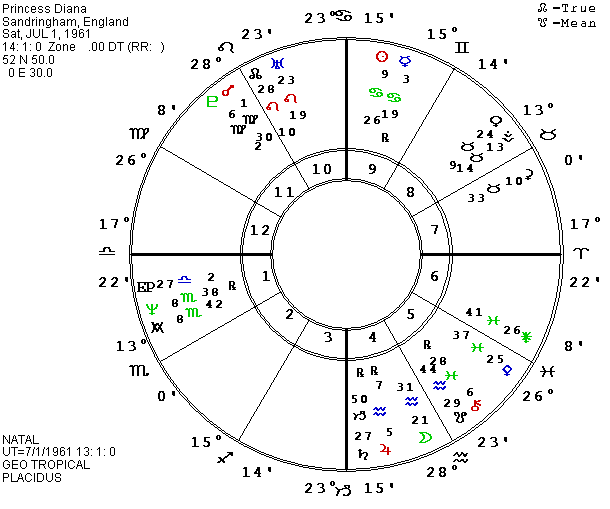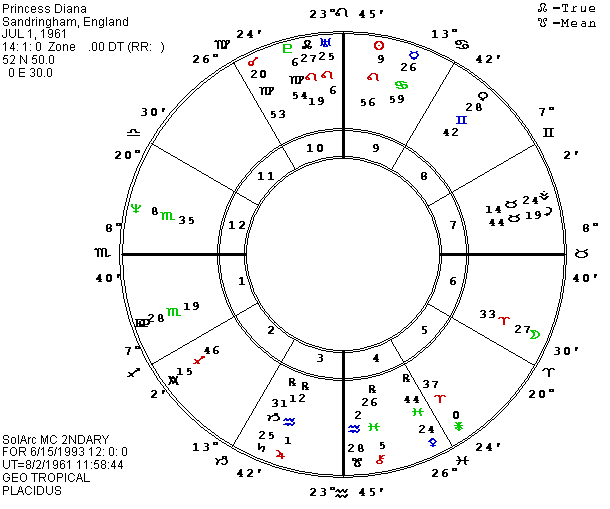Diana According To Her Astrologer
Zip Dobyns
Penny Thornton, a well-known London astrologer, has written a just-published book about her work as a consultant to Princess Diana. In it, she reports that like most astrologers, she was originally working with the wrong birth time for Diana. According to Penny, the Palace Press Office originally gave Diana’s time of birth as 2 P.M. on July 1, 1961 at Sandringham, England. But within a week or so, the time was changed by the same office to 7:45 P.M. which is the time I have discussed in The Mutable Dilemma in the past. Penny counseled Diana for about 6 years, from the spring of 1986 to the spring of 1992, but it was not until 1988 that she discovered Diana’s approximate birth time. According to Diana’s mother, Diana was born “just before the start of play at Wimbledon—a little after 2 P.M.” Since previous articles have discussed several members of the royal family, and since Diana is still periodically in the news, I thought our readers would like to have a more accurate chart for Diana.


The chart presented here is calculated for 2:01 P.M. and it might be a few minutes later. The aspects in June 1993 when Charles and Diana agreed to separate put the P MC on Uranus and square Venus, but it could be on P Uranus instead. The marriage had been in trouble for years, really from its beginning according to Penny. P Ascendant on Neptune fits Diana’s emotional anguish. Neptune periods can point to ecstatic, mystical experiences for individuals with faith in a higher power and a sense of connection to it, or they can signal times of anxiety and/or depression including the urge to run away. Other appropriate angle aspects include P East Point square the true lunar nodes and quincunx P Venus. P Venus was just about to end a quincunx to Saturn, so a yod was still in orb. The yod or double quincunx is a classic aspect configuration for a major turning point in the life including separations from people, places, etc. P Antivertex was octile P Jupiter, and P Moon formed a cardinal cross with P Mercury, Saturn and the East Point. The combination of conflict aspects in both fixed and cardinal signs certainly pointed to a time of major power struggles in Diana’s life.
Turning back to a brief discussion of Diana’s natal chart, we can see the danger of projecting her personal power into other people with two keys to identity in the houses of partners or other lasting peer relationships. An Ascendant in Libra puts Aries in the seventh house, and Venus, the ruler of Libra, is in the eighth house. This tendency was certainly reinforced by marriage to a much older man who held a world position of great power and prestige. Diana’s emotional vulnerability was also shown by her Sun and Mercury in Cancer along with Saturn, Jupiter and the Moon in the Cancer house. She was looking for an ideal mate (or could tend to over-rate her mate) with Pallas and Juno in Pisces and Mercury, ruling part of the eighth house, in the ninth house. She would also want to be the perfect mother of perfect children with Chiron and Pisces in the fifth house. At the same time, with Neptune in the first house she could expect too much of herself and feel that she could never live up to the expectations of others. The placement of Mars, natural key to identity, and Pluto, ruler of the first house Scorpio, in Virgo would warn of the danger of self-criticism.
According to Penny’s book, Diana felt unloved by both of her parents. Her mother left the family when she was a child, and her father remarried a woman who was disliked by all the children, Diana and her two sisters and one brother. We can see in Diana’s chart that Saturn in its own sign is square the East Point axis and opposite the MC to form a cardinal cross with these angles, and it is also quincunx the north lunar node and Mars. The fourth house Jupiter is quincunx Mercury and the fourth house Moon opposes Uranus and squares Venus. The patterns suggest tension and the potential of the split between the parents as well as Diana’s tension with both parents and the possibility of her own relationships being turbulent. The psychological issues include both the handling of power and freedom-closeness ambivalence which is so common.
As readers know, Charles was in love with Camilla Parker Bowles long before the marriage and continued to stay in touch afterwards. Ceres in the seventh house suggests that Diana was looking for her lost mother in her mate. Vesta in a partnership house can indicate a desire for a competent mate but Vesta connected to any of the relationship sides of life, four, five, seven or eight, is like Virgo in those signs or houses or conjunct their rulers. Vesta warns of two dangers, either of which can lead to alienation in relationships. Vesta and Virgo can be very positive when connected to work where the tendency to look for flaws in order to do a better job can lead to success. But if we direct the critical attitude into relationships, it can lead to problems. The alternate danger is for either person to neglect the relationship through becoming too immersed in their “job” which can be anything that fulfills the need for a sense of achievement. Charles is a very inward, self-contained person who was not able to give Diana the emotional reassurance that she needed.
Turning to the asteroids, natal Diana at 15 Scorpio 19 has fewer aspects than I normally find for famous people. It did square Williams in 14 Leo and Damocles in 14 Aquarius within the one degree orb I use for the multiplicity of asteroids. It was also octile Elizabeth and Troja at 29 Virgo. What patterns it had are appropriate. Diana’s oldest son, William, may become the next King of England if Queen Elizabeth has a long life like her mother and if Charles does divorce and marry Camilla who has left her husband. The Church of England does not permit remarriage after a divorce. But the scandals involving several members of the royal family throw doubt on whether the country will retain the monarchy. Damocles opposite Williams and square Diana reminds us of the famous hanging sword which fits the questions hanging over William and Diana as well as Charles. Troja was named for the Trojan war, so its conjunction with Elizabeth and their conflict aspects to William, Diana, and Damocles describe the tense relationships.
P Diana had moved to 18 Leo 12 when Diana and Charles agreed to separate. Its aspects included a conjunction to P Eros as Diana desperately sought love. It squared natal Minerva a goddess of wisdom and P Wisdom in 18 Leo as her hunger for love led Diana to engage in a variety of unwise actions with other men. It opposed Victoria which could be connected to the struggle with Charles in which neither side could really claim victory though some commentators gave Diana the edge. Victoria could also remind us of the highly successful queen of England and the current challenge to the monarchy to which Diana has contributed. P Diana was also octile Sisyphus (who kept rolling the rock uphill, but it always rolled down again) and Vaticana; both in 3 Libra. The Anglican (English) church is similar to the Vatican in its opposition to remarriage and Diana’s attempts to find love have been as futile as the efforts of Sisyphus. P Juno trioctile natal Diana offered another indication of Diana’s tension with her mate.
Natal Charlois (the French version of Charles) was in 14 Libra and P Nemesis is holding a conjunction with it for some years as Charles reaps the consequences of past indiscretions. P Charles at 23 Libra was sextile Uranus (as he gained freedom) and quincunx Venus (as he separated from his partner).
There is always more that could be said, but I will close with the suggestion that we watch the period of late 1997 into the early years of the next century when Diana’s P Sun will square her natal and then P Diana. Penny Thornton’s book includes some speculations on the future of the monarchy and the years at the end of this decade may be its D-day. Penny thinks England may become a republic. For those interested in the royal family, Penny’s book is fascinating and well-worth reading.